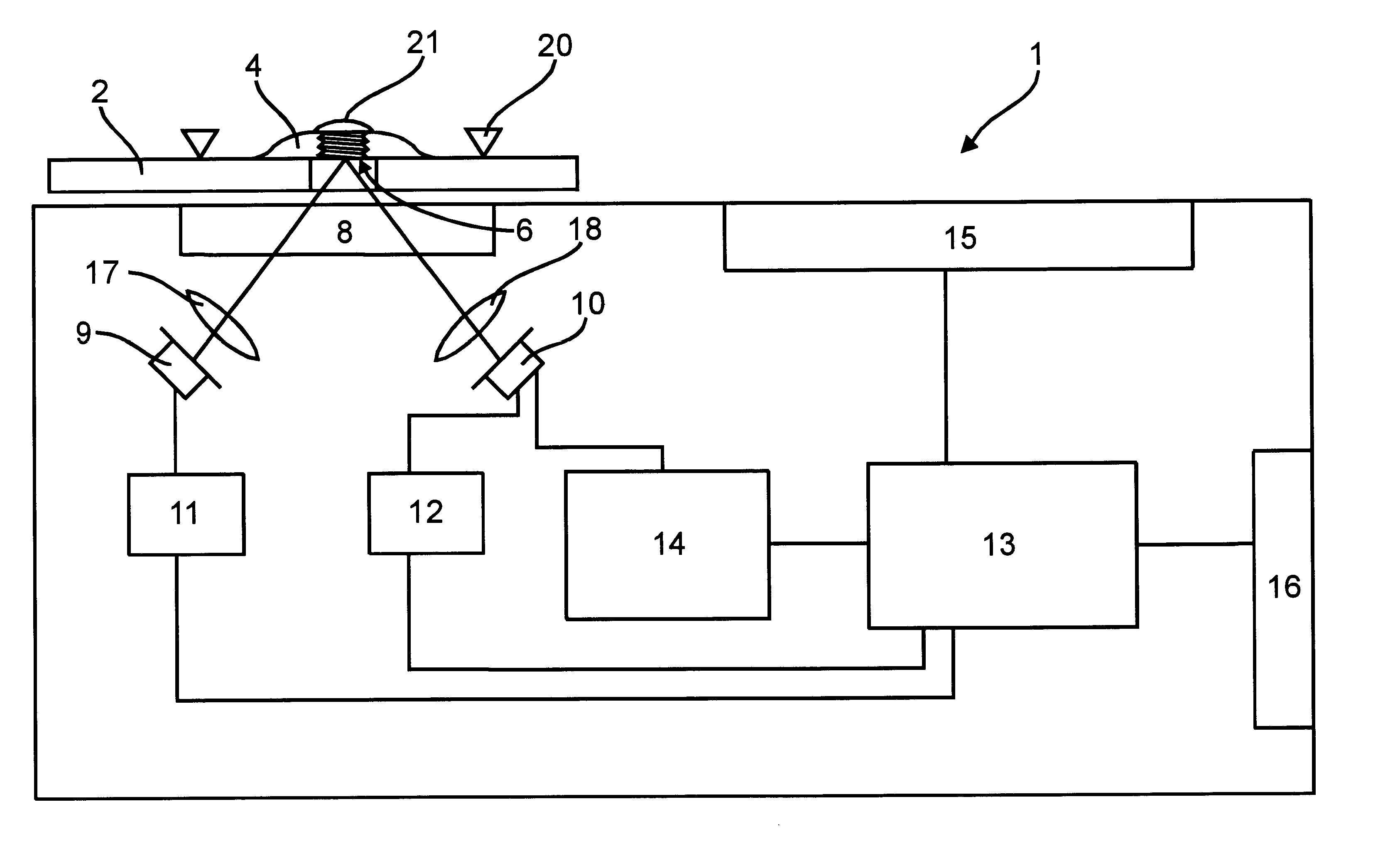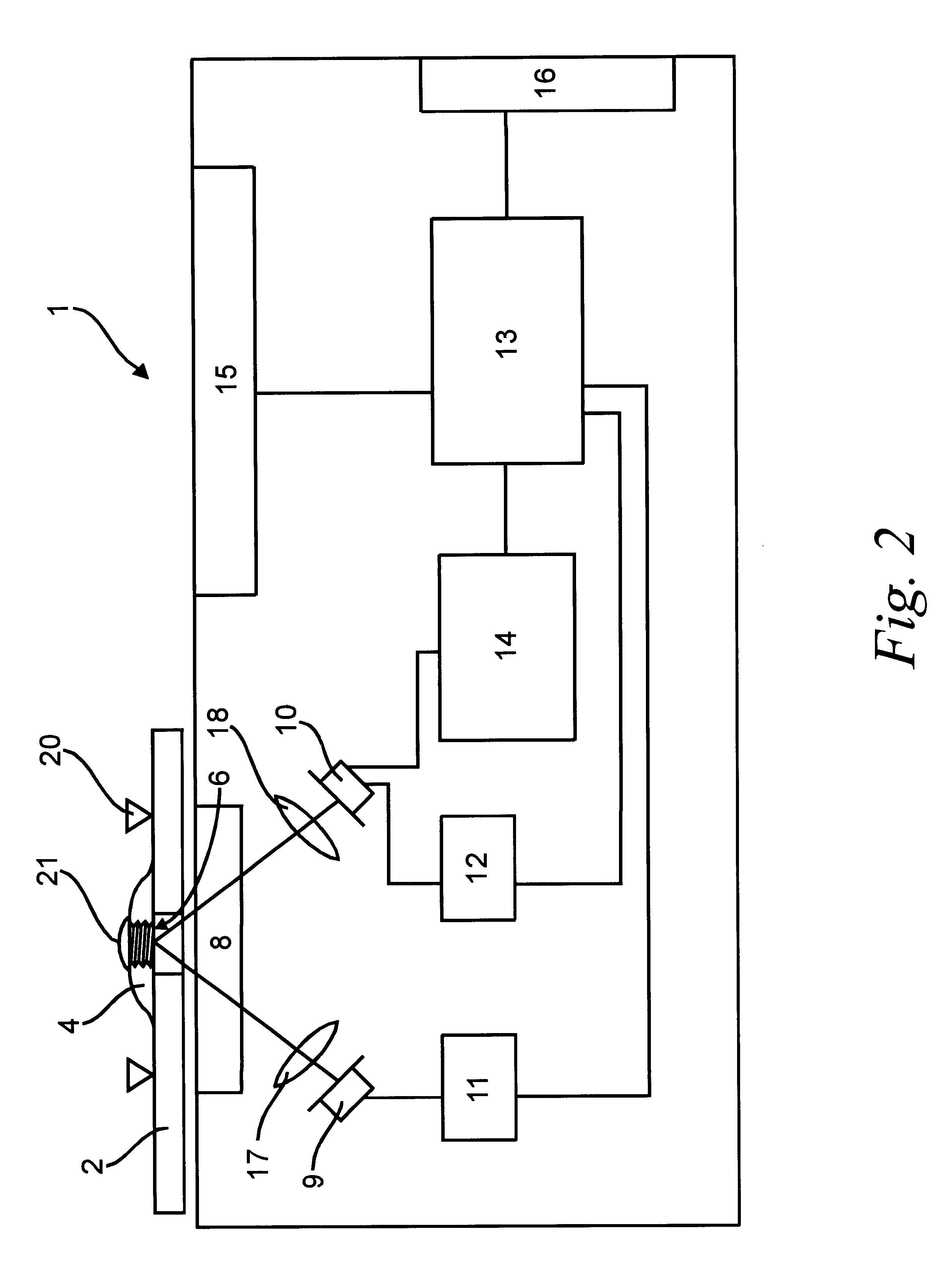This is achieved in newer devices by measuring quasi-continuously the reflection curve, and by determining dynamically the Final measurement time. This latter process contradicts the requirement for simple operations and calculations. This is an important aspect, because the
blood glucose measurement devices should be small and portable (i.e., operating from battery), be simple to operate, and, last but not least, be cheap.
A continuous reflection measurement requires the continuous or frequent switching on / off of the
light source, typically a LED, and inevitably have a high
power consumption. Therefore, it is sought to substitute the
continuous measurement with sampling on a frequency as low as possible. It may also be mentioned that a more complicated method requires a more sophisticated controlling processor, which is more expensive. On the other hand, a more complicated
algorithm, in a given processor in a given time, allows the evaluation of fewer measurement points, which in turn will result in a less precise measurement. It is less significant, but may be taken into consideration that the
power consumption of the processor is higher with more calculating steps. This latter factor may play a role if the controlling
algorithm of the device is not made by
digital processor but by analog circuits, e.g. due to considerations of reliability. With
higher power consumption the device will operate for a shorter time, so indirectly its reliability will worsen (i.e. the probability of malfunction due to the run-down of the batteries will increase).
Therefore, it is an object of the present invention to provide a method, which allows the determination of the measurement time in a manner avoiding or at least minimizing the disadvantages of the known solutions. Further objectives of the present invention are to determine the measurement time with a
simple algorithm, and to determine a measurement time, which is set at or near the ideal time, dependent on the glucose content to be measured. It is still a further object to provide a method where the sampling frequency may be kept relatively low, in order to keep the power consumption low. Because the light sources of the measurement devices are normally the largest energy users, this is an important factor. The blood glucose measurements are also negatively affected by temperature variations, hence it is preferable that the method of the invention should deliver results independent of the measurement temperature.
On the other hand, when the actual values are determined by interpolating the measured values, then the method according to the present invention may be applied advantageously for the so-called quick strips, where the reactions take place quickly. For example, the sampling frequency can be reduced so that the T.sub.m time point is made equal not to the n-th value T.sub.n in which T.sub.n time we would first observe the reaching of the C(t) function, but the exact value of T.sub.m can be a point of time determined by interpolating between the time T.sub.n and T.sub.n-1, where T.sub.m is defined by the F*(T.sub.m)=
C value. Here, the function F*(t) is the linear or higher order approximation of the function F(t)=R(t)+L(t)-ext[R(t)-L(t)] laid through points T.sub.n-1, F(T.sub.n-1) and T.sub.n, F(T.sub.n). Of course, the measured reflection value R.sub.m can also be calculated from the reflection values R(T.sub.n) and R(T.sub.n-1) by interpolation. The error caused by the interpolation will be very small because in this time interval the variation of R is quite low. A further benefit is that the procedure is less sensitive to the deviations caused by the fluctuation of the
reaction rate, because it adjusts the measurement according to the variation in the
reaction rate. Therefore, the aging of the
test strips, the measurement temperature, vapor content and other factors affecting the reaction rate will but slightly deteriorate the accuracy of the glucose content measurement.
In one exemplary embodiment of the method according to the present invention, L(t) is a linear function with a predetermined slope [L(t)=At+B, preferably L(t)=At and B=O], while C(t) is a constant function [C(t)=C]. However, it is also possible that L(t) is a second-order or a higher order function of time. C(t) can be specified, for example, in a more general polynomial form as well. Preferably, the wetting through of the sample is detected on the basis of a predetermined amount of change in reflection. This requires merely a comparison with a threshold value, therefore, its demand for
processing power is rather modest. However, it may be more advantageous if the wetting through of the sample is detected by a predetermined rate of change in reflection. With this method it is possible to filter out the effects of, for example, the inadvertent moving of the sample and the reductions in reflection not involving a real reaction. Alternatively, the wetting of the sample may be detected on the basis of the reflection value reaching a predetermined
limit value. This simplifies the
programming of the processor, because in the starting phase it requires the storing of a single reflection value at one time.
 Login to View More
Login to View More 


